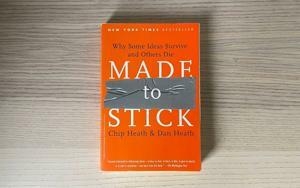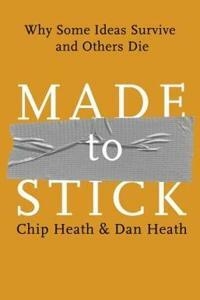This website uses cookies
This website uses cookies. For further information on how we use cookies you can read our Privacy and Cookie notice
This website uses cookies. For further information on how we use cookies you can read our Privacy and Cookie notice
In stock
Easy Return, Quick Refund.Details
QABETE ENTERPRISES
88%Seller Score
62 Followers
Shipping speed: Excellent
Quality Score: Good
Customer Rating: Good





By Chip Heath & Dan Heath
Made to Stick explores why some ideas thrive while others fade away. Chip and Dan Heath present a blueprint for crafting messages that are understood, remembered, and acted upon—crucial for anyone aiming to communicate, educate, or inspire. Drawing on research, real stories, and hands-on frameworks, the book distills the anatomy of "sticky ideas" and teaches practical methods for making any message impactful.
A core challenge the book addresses is the "curse of knowledge"—the idea that it's hard for experts to communicate simply because they can’t easily imagine what it’s like for others not to know what they know. This gap often leads to unclear messages that fail to connect or persuade1.
The Heath brothers introduce the SUCCESs framework—six characteristics shared by memorable, effective ideas62:
| Principle | What It Means | Example |
|---|---|---|
| Simple | Strip the idea to its core, finding clarity in brevity | Southwest Airlines: "THE low-fare airline" |
| Unexpected | Grab attention with surprise and insightful twists | Urban legends, curiosity gaps |
| Concrete | Use clear, sensory details and examples | Vivid analogies, statistics with context |
| Credible | Bolster with authorities, vivid details, or statistics | Expert testimony, anti-smoking ads with clear data |
| Emotional | Make people care by associating ideas with feelings | Charity appeals focused on a single child rather than stats |
| Stories | Embed ideas in stories to inspire action and simulate application | Famous urban legends, real-life anecdotes |
Simple: Distill messages to their essence, making them easy to understand and remember.
Unexpected: Defy audience expectations to create attention and teach something new.
Concrete: Avoid abstraction. Replace vagueness with tangible, real-world examples.
Credible: Anchor ideas with trusted sources or real-life detail so people believe them.
Emotional: Tap into what matters to people—relate ideas to core desires or values.
Stories: Inspire and move audiences by weaving information into storylines that prompt mental and emotional engagement652.
When pitching a product or teaching a lesson, focus on a core message—avoid jargon or overloading with information.
Capture attention with an unexpected element; use surprising statistics or counterintuitive insights to stand out.
Anchor your message in concrete details (e.g., “as easy as using a paperclip”).
Build credibility by using testimonials or demonstrable results.
Evoke emotion: Show how your idea solves a problem people care about.
Tell stories: Share customer journeys, founder struggles, or real use cases to bring your message to life62.
The book is packed with vivid stories: from urban legends like the “kidney heist” to corporate tales of mission statements that motivate action.
Each chapter includes a “Clinic,” applying principles to real-world messaging challenges.
Tools like the Velcro Theory of Memory and curiosity gaps make lessons actionable for anyone from small business owners to educators56.
If you’re a small business leader, entrepreneur, teacher, or anyone who wants your ideas to matter, Made to Stick arms you with proven tools to communicate so your ideas will not just be heard, but remembered and acted upon562.





By Chip Heath & Dan Heath
Made to Stick explores why some ideas thrive while others fade away. Chip and Dan Heath present a blueprint for crafting messages that are understood, remembered, and acted upon—crucial for anyone aiming to communicate, educate, or inspire. Drawing on research, real stories, and hands-on frameworks, the book distills the anatomy of "sticky ideas" and teaches practical methods for making any message impactful.
A core challenge the book addresses is the "curse of knowledge"—the idea that it's hard for experts to communicate simply because they can’t easily imagine what it’s like for others not to know what they know. This gap often leads to unclear messages that fail to connect or persuade1.
The Heath brothers introduce the SUCCESs framework—six characteristics shared by memorable, effective ideas62:
| Principle | What It Means | Example |
|---|---|---|
| Simple | Strip the idea to its core, finding clarity in brevity | Southwest Airlines: "THE low-fare airline" |
| Unexpected | Grab attention with surprise and insightful twists | Urban legends, curiosity gaps |
| Concrete | Use clear, sensory details and examples | Vivid analogies, statistics with context |
| Credible | Bolster with authorities, vivid details, or statistics | Expert testimony, anti-smoking ads with clear data |
| Emotional | Make people care by associating ideas with feelings | Charity appeals focused on a single child rather than stats |
| Stories | Embed ideas in stories to inspire action and simulate application | Famous urban legends, real-life anecdotes |
Simple: Distill messages to their essence, making them easy to understand and remember.
Unexpected: Defy audience expectations to create attention and teach something new.
Concrete: Avoid abstraction. Replace vagueness with tangible, real-world examples.
Credible: Anchor ideas with trusted sources or real-life detail so people believe them.
Emotional: Tap into what matters to people—relate ideas to core desires or values.
Stories: Inspire and move audiences by weaving information into storylines that prompt mental and emotional engagement652.
When pitching a product or teaching a lesson, focus on a core message—avoid jargon or overloading with information.
Capture attention with an unexpected element; use surprising statistics or counterintuitive insights to stand out.
Anchor your message in concrete details (e.g., “as easy as using a paperclip”).
Build credibility by using testimonials or demonstrable results.
Evoke emotion: Show how your idea solves a problem people care about.
Tell stories: Share customer journeys, founder struggles, or real use cases to bring your message to life62.
The book is packed with vivid stories: from urban legends like the “kidney heist” to corporate tales of mission statements that motivate action.
Each chapter includes a “Clinic,” applying principles to real-world messaging challenges.
Tools like the Velcro Theory of Memory and curiosity gaps make lessons actionable for anyone from small business owners to educators56.
If you’re a small business leader, entrepreneur, teacher, or anyone who wants your ideas to matter, Made to Stick arms you with proven tools to communicate so your ideas will not just be heard, but remembered and acted upon562.
1 BOOK

This product has no ratings yet.
/product/65/1303523/1.jpg?0928)